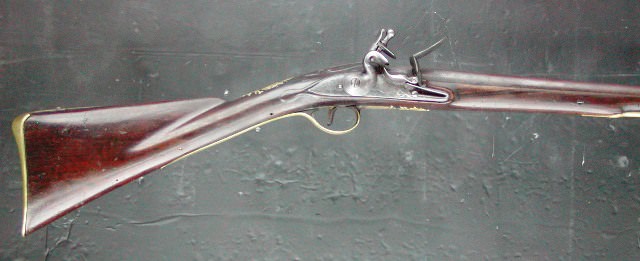Great story, Semisane. I wonder how many will appreciate your sense of humor.
granth, I assume you are asking about the very end of the butt or the shape of the buttplate and not the whole buttstock.
Unfortunately, your comparison is a bit of apples and oranges. The English gun you are comparing is a fowling piece or a period shotgun. The English did not have much of a rifle culture in the 18th and early 19th century. Rifles were almost the exclusive use of wealthy English land owners that had enough land to support deer and stag. Smoothbore fowling pieces were far more common in England than rifles.
In America, the fowling piece or shotgun had a flat buttplate pretty much like the English counterpart. There are some exceptions, but in general, American shotguns tended to have flat buttplates all the way up to modern times.
So maybe the better way to ask the question is why do fowlers have flat buttplates when American longrifles have curved or crescent shaped buttplates?
I'm not sure anyone knows. History certainly doesn't give us the answer.
The few examples we have of early American longrifles do have wide and flat buttplates. These generally follow the pattern of early Germanic rifles that were brought to the American colonies as well as rifles made in America by German emigrants that were trained in the Old Country.
Somewhere around the time of the American Revolution, the shape of the buttplate started a gradual change. They started to become a little more narrower in width and have a little more curve from the heel to the toe. This change wasn't universal with some gunmakers adopting the new trend while other gunmaker continued to maker rifles in the "old style". But by and large the trend took hold and is more noticeable in rifles made in the last decade of the 18th century and the first decade of the 18th century.
By the 1830s, the buttplate on most American longrifles have even more curvature and are more narrow. The trend continues pretty much through the rest of the muzzleloader period well past mid-century. The most extreme case is often seen on Southern Mountain Rifles, particularly in Tennessee, but many gunmakers from Pennsylvania to St. Louis to California built rifles with substantial curve in the butt plate. Henry Leman and the Hawken brothers come to mind.
Many people have speculated that the deep crescent shape was developed for practical reasons. Maybe, but it is easy to poke holes in these hypotheses. One of the common ones I hear or read is that the deep crescent made the rifle easier to shoot from horse back on the plains of the West. The problem I have is that people back east rode horses all the way back to the colonial period so what does riding a horse have to do with it. They might counter that shooting from the back of a horse would have been more common while hunting buffalo on the plains than riding a horse through the woods back east and trying to shoot a deer. But then how does this explain the deep crescent on Tennessee mountain rifles?
Also, people were riding horses on the plains of Missouri and Kansas prior to the 1830s. After all, William Ashley made his first expedition in 1822 and held the first mountain man rendezvous in 1825. There were earlier expeditions to the Southern Rocky Mountains and even to Santa Fe and the Santa Fe trade went into high gear after Mexico won is independence in 1821. The Lancaster pattern longrifle with a moderate crescent was probably the most common rifle on the plains and in the mountains from the time of the Lewis & Clark expedition until well into the 1830s. If the deep crescent was so much easier to shoot from horse back, it sure seemed to take the people crossing the plains a long time to learn that.
I think it is more plausible that the change from the wide and flat butt plate of the Colonial Period to the narrow and deep crescent of the mid-19th century was driven more by fashion and desire for something new and different than by any practical purpose. People back then weren't all that much different from people today and in each generation there were those that wanted something different than what grandpa or even dad used. We see it in the style and method of decorating rifles. We see it in barrel lengths and in the trend from fullstocks to halfstocks.












